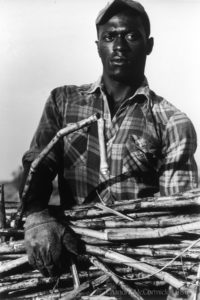Keith Calhoun and Chandra McCormick
Husband and wife documentary photographers Keith Calhoun and Chandra McCormick have dedicated their careers to examining and presenting the lives, spirit, and culture of black New Orleans.

Courtesy of Chandra McCormick.
Chandra McCormick's black and white photograph "Mark Gale, Sugar Cane Scrapper," was made in 1986.
Since the early 1980s, New Orleans–based photographers Keith Calhoun and Chandra McCormick have chronicled the African American experience in New Orleans and the surrounding Louisiana countryside. Working as a team, the couple chronicles the unique traditions and deep-rooted attributes of Louisiana culture that increasingly represent a vanishing way of life. Their images bear witness to both the celebrations and struggles of everyday events, with particular attention to the profound sense of place felt by Louisianans. When Hurricane Katrina struck in 2005, their photographic archive was nearly destroyed, yet their work has proved resilient. Calhoun and McCormick’s images have appeared twice in Aperture and have been included in the book Reflections in Black: A History of Black Photographers, 1840 to the Present. Their work has been exhibited at venues including the Brooklyn Museum in New York City; the National Civil Rights Museum in Memphis, Tennessee; the New Orleans Museum of Art; New York University; the Philadelphia African American Museum in Pennsylvania; and the Smithsonian Institution.
Keith Calhoun and Chandra McCormick were both born in the Ninth Ward of New Orleans to working-class families, on January 1, 1955, and August 27, 1957, respectively. In the 1970s, Calhoun attended classes at Los Angeles Community College in California, honing both his technical skills and his eye for social issues while working as a cameraman for public television station KCET. Upon returning to New Orleans, Calhoun started a portrait studio, where he met McCormick, at first a portrait subject and later his apprentice. Their relationship developed into a lifelong working partnership and marriage.
“We documented the soul of the city,” Calhoun told the Houston Chronicle in regard to the couple’s work. “We documented vanishing Louisiana—the last of the sugar cane workers, the dockworkers, the sweet potato harvesters. We dealt with the displacement of African Americans throughout Louisiana.” They also photographed the “traditions unchanged” of black church services and religious rituals; community rites and celebrations such as parades, jazz funerals, and second lines; and the cruel conditions of the Louisiana State Penitentiary, known as Angola.
Like many residents of New Orleans, Calhoun and McCormick were devastated by the catastrophe of Hurricane Katrina. As the storm approached the city, the couple prepared to evacuate their Lower Ninth Ward home and studio by securing their photographic archive in Rubbermaid bins on high shelves, yet upon returning more than two months later and sifting through the debris of their ruined house, they found two-thirds of the archive destroyed by water damage. Historian Douglas Brinkley described the two prominent images that encapsulate the cultural loss of the Lower Ninth Ward as “Fats Domino’s piano in debris and Keith and Chandra’s photographs floating away.” The older of their two sons, Keith, Jr., suggested they freeze the waterlogged materials to halt their deterioration. They later developed a technique to reproduce, digitally scan, and print the damaged photographic negatives and transparencies, resulting in a brilliant series of images that toe the line between representation and abstraction, simultaneously memorializing the subjects first photographed and the trauma of the flood.
Since Katrina, Calhoun and McCormick have continued to preserve the traditions of the New Orleans African American community. Their post-storm photography has focused on subjects such as the previously unsung heroes of the storm who assisted others in the face of danger and the effects of evacuation and displacement on the local community. In addition, they established the L9 Center for the Arts in 2007, with the mission to promote creativity in their community.
Impressed by an exhibition at the Ogden Museum of Southern Art in 2014, Okwui Enwezor, the curator of the Venice Biennale, invited Calhoun and McCormick to participate in the 2015 gathering of artists in Italy in what is considered the most revered international art exhibition in the world.
